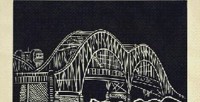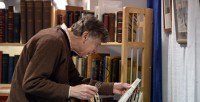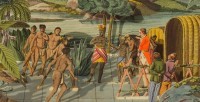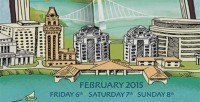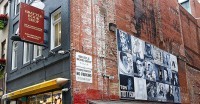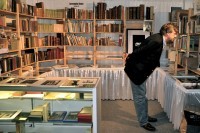Three years ago, I took part in one of the ABA's Book Collecting Seminars at the University of London: Book Collecting and the Web. Now, there are many different views about what the internet has done for booksellers (watch a few of the earlier interviews conducted by Michael Ginsberg) and for collectors (a very recent view here). For my part, I like the internet: it has given me access to a wealth of information previously unavailable to me to help me research the books I have for sale, and given me access to a much wider audience than before it existed. But what about you, the collector? Certainly, any worries you may have about buying books on the internet are nothing new. In the late 1990s, when people first began to look for books online and booksellers began listing their stock, the exact same concerns were voiced then as they are now: is the person with a PO Box address in the middle of nowhere a real shop, or just someone with a few books in his garage? Can you trust his description? Does he know anything about condition? Or rarity? Or price? (Of course, you can buy with confidence from any ILAB-affiliated bookseller.) And the websites which allow you to look for books haven't really changed, either. Facilities to search only for first editions can still result in first American, first illustrated etc etc. A description for a particular copy may appear twice (or more) on the results page. Browsing is still very difficult. Some websites have tried to increase the chanc... [more The Show is My Shop]
Book Fairs
The 55th annual New York Antiquarian Book Fair takes place in New York City from April 9 to 12, 2015. Many ABAA member dealers will be exhibiting. Here are a selection of their featured items that will be available at the fair. Urban, Sylvanus (ie. David, Henry), ed. THE GENTLEMAN'S MAGAZINE: AND HISTORICAL CHRONICLE. FOR THE YEAR MDCCLXXIV MDCCLXXXIII . London: Printed at St. John's Gate for D. Henry, 1774-1783. 120 issues plus 8 supplements as issued (no supplements issued in 1774 and 1783). Illus. with 164 engraved portraits, figures, maps, and plans (75 folding, 1 facsimile) plus numerous in text drawings. 8vo. Full modern brown calf, five raised bands, red morocco spine labels, gilt titles and rules, in period style. ($14,500) Offered by Kaaterskill Books (Booth B6) --- Bartolo of Sassoferrato . . . Collation: a10, b-z8, A-C8, D-E6. 221 of 222 ff. Final leaf, a blank, lacking. Folio (16-1/2" x 11-1/4"). Contemporary quarter calf with blind tooling over wooden boards, raised bands and later hand-lettered title label to spine, clasps (and buckles) lacking. Several tiny wormholes, a few cracks to spine, chip to foot of spine, Signatures a and E6 partially detached, bookplate of Robert Proctor and bookseller description from the Rosenbach company to verso of front board, pastedowns lacking (or never present). Text printed in 60-line gothic type on wide-margined paper, initial spaces filled in alternate red and blue, most with flourishes, seven-line initial "Q" at beginning o... [more NY Antiquarian Book Fair: Featured Items]
What could be more fun than spending two days pouring over old magazines, pamphlets, prints, letters, diaries, photos, advertising, account books, political fliers and broadsides, trade cards, baseball cards, posters, menus, valentines, historical documents, song sheets and songsters, alphabets, juveniles and primers, post cards, labels, stock certificates, passports and old newspapers – to name only a few? If your answer is “Nothing!” you needed to be at the Hyatt Regency Hotel in Greenwich, CT this weekend, for the 35th annual Conference and Paper Show of the Ephemera Society of America. The theme this year was “The Sporting Life” and conference organizers provided a full slate of sports oriented lectures, presentations, book signings, social events, an auction and, oh yes, a paper and ephemera show. Of course, since we are still in the grips of the memorable “Winter it Snowed,” it snowed. Over six inches in as many hours – just like a Viagra ad! The white stuff brought its usual quotient of misery during load in but, interestingly, had little effect on attendance. Most of the attendees were there for the other Conference events, and were already ensconced in the comfortable Hyatt Regency hotel. For this reason, and because of continuity of venue and promoters, AND (big “and” here) because of the credibility provided by the Ephemera Society, this is the most stable of all provincial fairs. The benefits of stability are many – there are no unpleasant s... [more What Could be More Fun?]
The New York Antiquarian Book Fair will enthrall bibliophiles at the Park Avenue Armory from April 9 through 12, 2015. “The Best Book Fair in the World” This three-day event is one of the largest antiquarian book fairs in the United States, and draws over 200 rare book dealers from across the country and around the world. Sponsored by the Antiquarian Bookseller's Association of America and the International League of Antiquarian Booksellers, the event is the centerpiece of Rare Book Week, a “coordinated effort to focus attention on the antiquarian book fairs, book & manuscript auctions, rare book & fine art exhibits, and bookish browsing available in New York City from April 7-15,” according to Fine Books Magazine. Where: Park Avenue Armory, 643 Park Avenue, NY, NY 10065 When: April 9 - 12, 2015 Friday: Noon-8pm Saturday: Noon-7pm Sunday: Noon-5pm Rare Book Week's events include two shadow shows, and numerous exhibitions and auctions of rare books and ephemera around New York City. Featured item: Allen, John Fisk. VICTORIA REGIA; OR THE GREAT WATER LILY OF AMERICA. With a brief account of its Discovery and Introduction into Cultivation: with Illustrations by William Sharp, from Specimens Grown at Salem, Massachusetts, USA. Boston: Printed and published for the author, 1854. A cornerstone of American color printing. These images were drawn on stone and printed by Sharp, America's first chromolithographic printer. This was the earliest example of large scale color print... [more New York Antiquarian Book Fair 2015]
Along with robins and daylight savings time, the Washington Antiquarian Book Fair is the harbinger of spring. In the old days, I'd drive down to the house of my friends who run Bartleby's Books, park my car in their driveway, and take a long, pleasant, shirtsleeved walk down Wisconsin Avenue to their shop in Georgetown, delighting in forsythias, daffodils, and short dresses along the way. But their shop has been closed for four years, and it's a good thing, too. Their business is thriving at home, and I would have needed skis to make the walk this year. As it was, finding our way across the Key Bridge to site of the book fair at the Holiday Inn in Roslyn, VA, was an arctic excursion, fraught with ice patches, snow banks and potholes. Promoter Beth Campbell and her helpful staff made move in a snap, but no one was too surprised that the line on opening night was shorter than usual. We'd just gotten several inches of snow – a blizzard in these parts – and DC officials were encouraging people to stay off the roads so that street cleaning could proceed. A word about Beth Campbell and the Washington Antiquarian Book Fair, if you will indulge me... The fair started as a fund raising event for Concord Hill School forty years ago. In its day it was, along with events in New York, Seattle, and St. Petersburg, one of the most successful provincial shows in the country. A bookseller could – and many did – make a decent living shuttling from one of these events to the next. All ... [more Frozen: Washington Antiquarian Book Fair]
Exhibiting booksellers at the 48th annual California International Antiquarian Book Fair have announced some unusual and notable items that will be for sale at the fair (being held at the Marriott Oakland City Center, Oakland, CA from February 6 to 8, 2015). Some of these special items include: Overdue Bar Tab Invoice for Jimi Hendrix, 1969 “Even the world's greatest rock guitarist can forget to pay his tab once in a while. Hendrix spent a Halloween evening at “The Scene” nightclub in New York in 1969, and apparently, skipped out on his tab. The invoice for $44.25 is from owner Steve Paul stating that “The Scene needs the money badly. Your beverage tab is Past Due.” Hopefully he left a tip!” (Schubertiade Music & Arts LLC, Booth 106, $1,200) The First English Sex Manual from 1684 “Entitled Aristotle's Masterpiece, although not written by Aristotle or a masterpiece, this 17th century primer provides practical advice on copulation, conception, pregnancy and birth. Needless to say, this was an extremely popular book in its time, going through more than 100 editions over two centuries. While not intended as pornography, the graphic nature of the book caused it to be printed and sold “under the table.” One wonders how many teenaged English boys kept a copy hidden under their bed!” (Jeremy Norman HistoryofScience.com, Booth 809, $65,000) Aristotle's Masterpiece Courtesy Jeremy Norman HistoryofScience.com, Booth 809, $65,000 The Heritage Edition of the St. John's... [more CA Book Fair 2015: Featured Items]
I've always enjoyed the international nature of the book trade. Buying books from all over the world, and selling them to collectors all over world: what could be better than that? Livres sans frontières. The coming month will see me do just that. This week, I shall be in Stuttgart for the 54th Stuttgarter Antiquariatsmesse. Then, two weeks later, I travel to Oakland for the 48th California International Antiquarian Book Fair. Both fairs will see lots of British booksellers in attendance, whether 'shopping' or as exhibitors. There's always a certain buzz about Stuttgart: the first major fair of the New Year, everyone keen to get hunting to see what they can find. I can remember going to my first Stuttgart fair, back in 1999. In those days, you still had the 'running.' For those who never experienced it, I shall explain. At German book fairs, there is usually a general fair catalogue, which lists details of certain books the various booksellers will be exhibiting at the fair. Importantly, these books must be available when the fair opens: exhibitors are not allowed to sell anything listed in the fair catalogue before the fair. That used to mean that if you really wanted something listed in the fair catalogue, you had to run for it when the fair opened. People would employ young, athletic types (often local students) to run for books. Or you could run yourself. You had to get there early, of course, perhaps an hour before the fair was due to open, to make sure of your place in... [more On Your Marks, Get Set…]
We are just weeks away from the 48th California International Antiquarian Book Fair (February 6-8, 2015), the world's great Northern California rare book fair, and organizers have an extensive schedule of special events and seminars to surprise and delight both experienced collectors and those curious to begin. This year, the festival moves to a new location in historic Oakland, CA, affording easy access and superb facilities at the Oakland Marriott City Center. Along with exhibits by over 185 rare book dealers from the U.S. and abroad, there are many special events planned: Lecture by Daniel De Simone Saturday, February 7 at 1pm The ABAA and the Bibliographical Society of America are sponsoring a lecture on “Building New Audiences for Rare Books” by Daniel De Simone, Eric Weinmann Librarian at the Folger Shakespeare Museum. Educational Events for New Book Collectors Sunday, February 8 11:30am: Book Collecting 101 Learn how to judge a book's condition, where to buy quality rare books, the characteristics that distinguish a true first edition, how to shape a collection, and much more. 12:15 pm: What's This Book Worth? Professional appraisers will discuss the factors that give books commercial and monetary value. 1pm: Discovery Day Exhibitors will offer interested attendees up to three free appraisals, so if you think you may have an item of special interest, this is a valuable opportunity to have it assessed. "Jack London, Photographer": A Lecture by Sara S. Hodson Sunday,... [more 48th Annual California Antiquarian Book Fair]
Things have changed in the Boston since the first ABAA Boston Book Fair was launched. And in a profession that deals in the old, change can be a good thing. There were shops that were within walking distance from each other. Others were a short subway ride or car ride away. And while we're going down memory lane, let's include Cambridge and a suburb or two. (Greg, Gloucester is not a suburb of Boston, but I'll mention you anyway). Back in the day (let's use the first ABAA Boston Book Fair as a reference point), there was Brattle, Goodspeed's, Starr, Sam Morrill, F.A. Bernett, Temple Bar, The Bromers, Mike Ginsberg, Robin Bledsoe, Ernie Morrell, the O'Neals (David and Mary,) the O'Neills (Jimmy and Gene), and Harold Burstein. Change came about in a variety of ways. Goodspeed's lost momentum during the 1990s. As a result, George closed the 'used book' shop on Milk Street and moved his 'rare book' shop from its Beacon Street retail shop to an office. Eventually the shop closed and George died in 1997 without leaving an heir. Ernie Starr and Sam Morrill passed, too. Norm Starr ran the shop for a while, but with soaring rent, he moved to Cambridge, then further out, and eventually closed shop. Ernie Morrell had a lovely shop of dance and theater arts books on the flat of Beacon Hill. Harold Burstein, one of the founders of the Boston Book Fair, dealt from Waltham, not too far out from the City. His legacy continues, but further west, in Bernardston, MA. The Cantabrigians also fell... [more Changes: The Boston Bookstore Scene]
I've been asked to dredge up a few memories about the Boston book fair, the venues it occupied prior to its current home at the Hynes Convention Center, and some of the dealers who exhibited in Boston in previous generations. Our firm, Howard S. Mott, Inc., is one of six firms to have exhibited at every Boston book fair since its inception in 1976, the upcoming fair being the 38th Annual. The others are Brattle Book Shop, Michael Ginsberg, aGatherin', Rulon-Miller, and Phil McBlain. The idea for the book fair came from Harold Burstein, and at the first exploratory meeting were Harold, Ken Gloss, Ken Rendell, and Mike Ginsberg. When the Boston Antiquarian Book Fair began our firm was still a member of the Mid-Atlantic Chapter of the ABAA. The firm started business life in New York City when there was no New England Chapter, and twenty years later, after my father and mother moved the family to Massachusetts in 1956, there was still no NE Chapter. When such a chapter was established my parents were slow to make the change. Thus, we were not involved with the creation of the fair. The early fairs were managed by Anne Bromer's mother, the indomitable Florence Finn. She was small in stature, but large in personality and authority. No problem was too big or too small for her, and she ran the show beautifully until she retired after something on the order of ten years at the helm. The first few fairs were held at the Copley Plaza Hotel, and they started slowly despite its ideal loca... [more Recollections Of The Boston Book Fair, By A Lifer]



